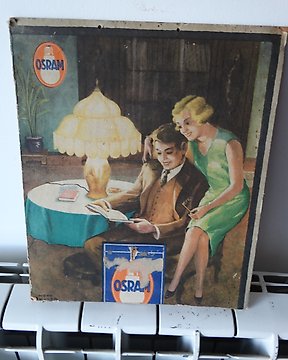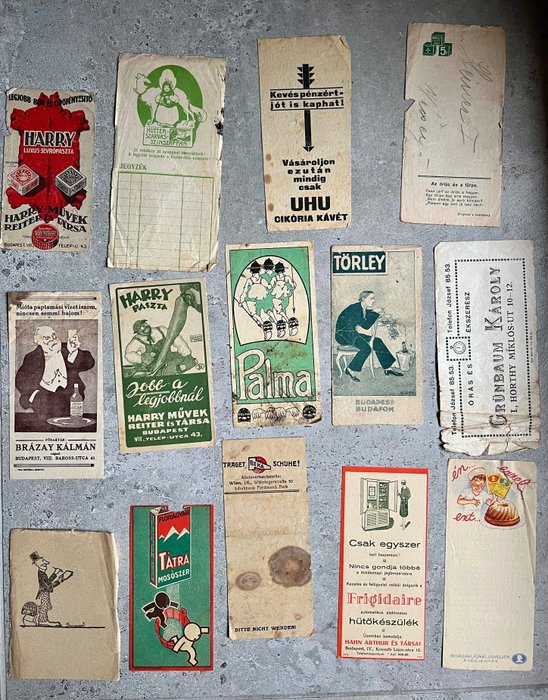
os - Osram publicidade
Nº 77785517

Nº 77785517

A Great and 100% original selection of the unique genre of counting tickets from the 1920-1930s
Hungarian counting tickets, or "számcédula," share a symbiotic relationship with Hungarian poster art, creating a fascinating interplay between currency and visual expression. These small denominations serve not only as a means of exchange but also as canvases for artistic representation, connecting the economic realm with the vibrant world of Hungarian poster design.
In Hungary, counting tickets have become a unique platform for artistic expression, with intricate designs reflecting the nation's cultural identity. The fusion of art and finance is particularly evident in the incorporation of national symbols, historical figures, and folk motifs on these tickets. This artistic integration transforms currency into a storytelling medium, narrating Hungary's history through visual symbolism.
The relationship between counting tickets and Hungarian poster art extends beyond the intricacies of design. Both share a commitment to capturing attention and conveying messages effectively. In the case of counting tickets, the challenge lies in encapsulating the essence of Hungarian culture and history within limited space. This artistic constraint fosters creativity, leading to visually engaging designs that make each counting ticket a piece of miniature poster art.
Furthermore, the influence is reciprocal. The bold, graphic styles prevalent in Hungarian poster art have left an indelible mark on counting tickets. The dynamic and expressive qualities of poster design find their way onto these small denominations, creating a fusion of artistic styles that transcends traditional boundaries between finance and aesthetics.
In conclusion, Hungarian counting tickets and poster art engage in a dynamic dialogue, enriching each other with cultural significance and visual allure. This interconnectedness elevates counting tickets from mere financial instruments to artistic reflections of Hungary's identity, making them a captivating intersection of art and commerce.
—
About Hungarian Poster Art
Hungarian poster art has long been celebrated for its unique and captivating style, making it a significant cultural and artistic movement in the world. From the late 19th century to the present day, Hungarian poster art has left an indelible mark on the global art scene, with its innovative techniques, bold designs, and powerful messages.
One of the highlights of Hungarian poster art is its ability to seamlessly blend various artistic styles and influences. The movement drew inspiration from a wide range of sources, including Art Nouveau, Constructivism, and Surrealism, resulting in a diverse and eclectic body of work. Artists such as Mihály Bíró, József Bottlik, and István Irsai pushed the boundaries of traditional poster design, experimenting with typography, color, and composition to create visually striking and thought-provoking pieces.
Another notable aspect of Hungarian poster art is its emphasis on storytelling and narrative. Unlike many other countries' posters, which primarily served as advertising tools, Hungarian posters often conveyed a deeper meaning or social commentary. They were not just meant to sell products but also to engage viewers intellectually and emotionally. This storytelling approach allowed Hungarian poster art to transcend its commercial purpose and become a powerful medium for social and political expression.
The importance of Hungarian poster art in the world cannot be overstated. During the early 20th century, Hungary was at the forefront of graphic design, and its posters gained international recognition and acclaim. The Budapest School, a group of Hungarian artists, revolutionized the field with their avant-garde approach, influencing poster art movements across Europe and beyond. Their innovative techniques and artistic vision set new standards for poster design, inspiring generations of artists worldwide.
Furthermore, Hungarian poster art played a crucial role in shaping public opinion and mobilizing society. In times of political turmoil and social change, posters became a powerful tool for propaganda and activism. During World War II and the Hungarian Revolution of 1956, posters were used to rally support, convey messages of resistance, and document historical events. The ability of Hungarian artists to capture the spirit of the times and communicate complex ideas through visual imagery made their posters an integral part of the nation's cultural and political identity.
Today, Hungarian poster art continues to thrive, with contemporary artists carrying on the legacy of their predecessors. The Hungarian Poster Museum in Budapest showcases the rich history and evolution of this art form, attracting visitors from around the world. The enduring appeal and influence of Hungarian poster art can be seen in the works of renowned artists like Tibor Helényi and István Orosz, who have successfully merged traditional techniques with modern aesthetics.
In conclusion, Hungarian poster art stands as a testament to the country's artistic prowess and cultural heritage. Its unique style, emphasis on storytelling, and ability to provoke thought and emotion have made it an important and influential movement in the world. From its early beginnings to the present day, Hungarian poster art continues to captivate audiences and inspire artists, leaving an indelible mark on the global art scene.
-
Please note that our company was founded in 1994 and it is internationally trackable. Invoice is available upon request.
Our team consists of members with university degree of art, painting valuation experts and experienced art&antique dealers
Invest in valuable works of art and objects at prices much lower than those of galleries. The offerings of IKEA, KIKA, etc. are similar in price for prints, so it is worth purchasing handmade pieces with history and value.
Feel free to ask as much as you want. Lifetime warranty is available for all items originality.
Shipping is with insurance.
Comment acheter sur Catawiki ?
1. Découvrez des objets d’exception
2. Faites la meilleure offre
3. Effectuez un paiement sécurisé